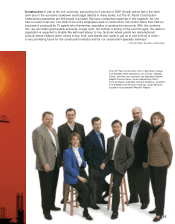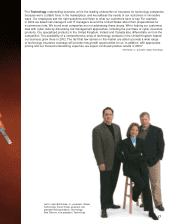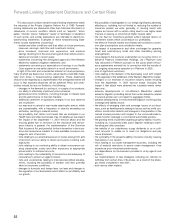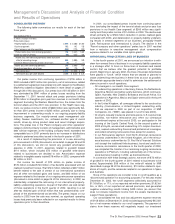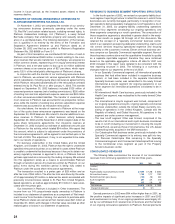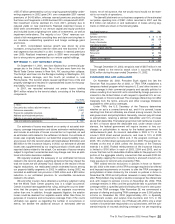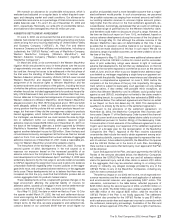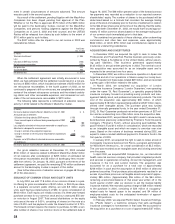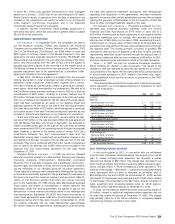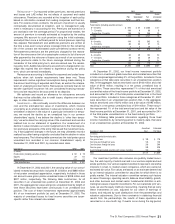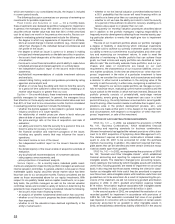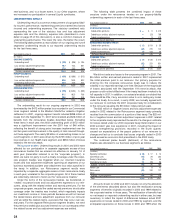Travelers 2002 Annual Report Download - page 27
Download and view the complete annual report
Please find page 27 of the 2002 Travelers annual report below. You can navigate through the pages in the report by either clicking on the pages listed below, or by using the keyword search tool below to find specific information within the annual report.
of $5.47 billion generated by our four ongoing property-liability under-
writing segments in 2002 grew 24% over comparable 2001 earned
premiums of $4.43 billion, whereas earned premiums produced by
the three runoff segments in 2002 declined 33% compared with 2001.
Net investment income declined 4% from 2001, primarily due to
reduced yields on new investments. Realized investment losses in
2002 were concentrated in our venture capital and equity portfolios
and included losses originating from sales of investments, as well as
impairment write-downs. The majority of our “Other” revenues con-
sisted of risk management consulting fees and claim servicing fees in
our insurance underwriting operations and foreign exchange gains
and losses.
In 2001, consolidated revenue growth was driven by price
increases, strong business retention rates and new business in sev-
eral segments that resulted in a 30% increase in earned premiums
over 2000. Realized investment gains in 2000 were unusually high
due to strong returns generated by our venture capital holdings.
SEPTEMBER 11, 2001 TERRORIST ATTACK
On September 11, 2001, terrorists hijacked four commercial pas-
senger jets in the United States. Two of the jets were flown into the
World Trade Center towers in New York, NY, causing their collapse.
The third jet was flown into the Pentagon building in Washington, DC,
causing severe damage, and the fourth jet crashed in rural
Pennsylvania. This terrorist attack caused significant loss of life and
property damage and resulted in unprecedented losses for the prop-
erty-liability insurance industry.
In 2001, we recorded estimated net pretax losses totaling
$941 million related to the terrorist attack, consisting of the following
components.
Year Ended
December 31
(In millions)
Gross pretax loss and loss adjustment expenses $2,299
Reinsurance recoverables (1,231)
Provision for uncollectible reinsurance 47
Additional and reinstatement premiums (83)
Reduction in reinsurance contingent commission expense (91)
Total estimated pretax operating loss $941
Our estimate of losses was based on a variety of actuarial tech-
niques, coverage interpretation and claims estimation methodologies,
and include an estimate of losses incurred but not reported, as well
as estimated costs related to the settlement of claims. Our estimate of
losses was originally based on our belief that property-liability insur-
ance losses from the terrorist attack will total between $30 billion and
$35 billion for the insurance industry. In 2002, our estimate of ultimate
losses was supplemented by our ongoing analysis of both paid and
reported claims related to the attack. Our estimate of losses remains
subject to significant uncertainties and may change over time as addi-
tional information becomes available.
We regularly evaluate the adequacy of our estimated net losses
related to the terrorist attack, weighing all factors that may impact the
total net losses we will ultimately incur. Based on the results of those
regular evaluations, we reallocated certain estimated losses among
our property-liability segments in 2002. In addition, during 2002, we
recorded an additional loss provision of $20 million and a $33 million
reduction in our estimated provision for uncollectible reinsurance
related to the attack.
We and other insurers have obtained a summary judgment ruling
that the World Trade Center property loss is a single occurrence.
Certain insureds have appealed that ruling, asking the court to deter-
mine that the property loss constituted two separate occurrences
rather than one. In addition, through separate litigation, the aviation
losses could be deemed four separate events rather than three, for
purposes of insurance and reinsurance coverage. Even if the courts
ultimately rule against us regarding the number of occurrences or
events, we believe the additional amount of estimated after-tax
losses, net of reinsurance, that we would record would not be mate-
rial to our results of operations.
The (benefit) detriment on our business segments of the estimated
net pretax operating loss of $941 million recorded in 2001 and the
$13 million net reduction in and reallocation of losses among seg-
ments in 2002 are shown in the following table.
Years Ended December 31 2002 2001
(In millions)
Specialty Commercial $8 $52
Commercial Lines (30) 139
Surety & Construction —2
International & Lloyd’s (22) 95
Subtotal – ongoing segments (44) 288
Health Care —5
Reinsurance 24 556
Other 792
Subtotal – runoff segments 31 653
Total $(13) $941
Through December 31, 2002, we paid a total of $307 million in net
losses related to the terrorist attack since it occurred, including
$242 million during the year ended December 31, 2002.
TERRORISM RISK AND LEGISLATION
On November 26, 2002, President Bush signed into law the
Terrorism Risk Insurance Act of 2002, or TRIA. TRIA establishes a
temporary federal program which requires U.S. and other insurers to
offer coverage in their commercial property and casualty policies for
losses resulting from terrorists’ acts committed by foreign persons or
interests in the United States or with respect to specified U.S. air car-
riers, vessels or missions abroad.The coverage offered may not differ
materially from the terms, amounts and other coverage limitations
applicable to other policy coverages.
Under TRIA, the U.S. Secretary of the Treasury determines
whether an act is a covered terrorist act, and if it is covered, losses
resulting from that act ultimately are shared among insurers, the fed-
eral government and policyholders. Generally, insurers pay all losses
to policyholders, retaining a defined “deductible” and 10% of losses
above that deductible.The federal government will reimburse insurers
for 90% of losses above the deductible and, under certain circum-
stances, the federal government will require insurers to levy sur-
charges on policyholders to recoup for the federal government its
reimbursements paid. An insurer’s deductible in 2003 is 7% of the
insurer’s 2002 direct earned premiums, and rises to 10% of 2003
direct earned premiums in 2004 and, if the program continues in
2005, 15% of 2004 direct earned premiums in 2005. The program ter-
minates at the end of 2004 unless the Secretary of the Treasury
extends it to 2005. Federal reimbursement of the insurance industry
is limited to $100 billion in each of 2003, 2004 and 2005, and no
insurer that has met its deductible shall be liable for the payment of its
portion of the aggregate industry insured loss that exceeds $100 bil-
lion, thereby capping the insurance industry’s and each insurer’s ulti-
mate exposure to terrorist acts covered by TRIA.
TRIA voided terrorist exclusions in policies in-force on Novem-
ber 26, 2002 to the extent of the TRIA coverage required to be offered
and imposed requirements on insurers to offer the TRIA coverage to
policyholders at rates chosen by the insurers on policies in-force on
November 26, 2002 and all policies renewed or newly offered there-
after. Policyholders may accept or decline coverage at the offered rate
and, with respect to policies in-force on November 26, 2002, TRIA
coverage remains in effect until the policyholder fails to purchase the
coverage within a specified period following the insurer’s rate quota-
tion for the TRIA coverage. After November 26, we commenced a
process of offering and quoting TRIA coverage on over 5,000 policies
in-force on November 26, 2002 (approximately 40% in Specialty
Commercial’s excess and surplus lines business and 10% in the
Construction business center). As of February 28, 2003, only a small
number of insureds have responded to our quoted rates, with the sub-
stantial majority of insureds declining coverage or not yet responding
The St. Paul Companies 2002 Annual Report 25


